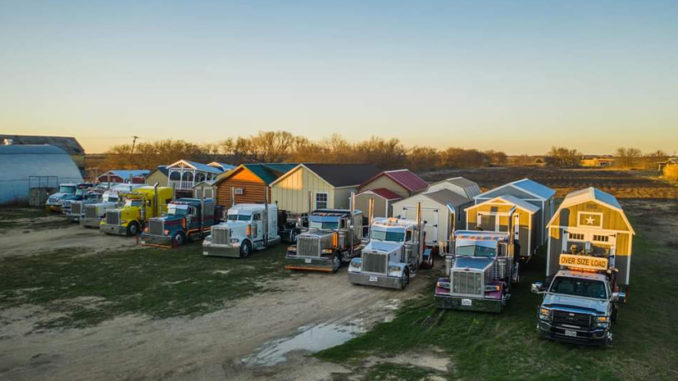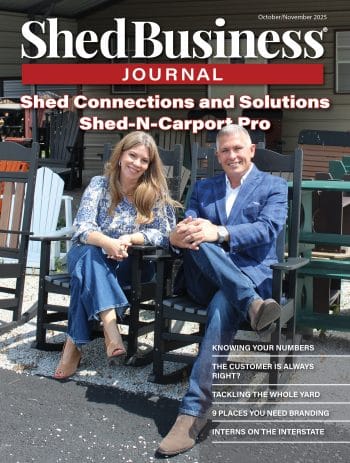
In most cases, your customers will spend more time with your delivery driver than any other person in your business. Additionally, they are often the last point of contact that a customer will have with your company.
Your customer’s overall experience often hinges on how well the delivery process goes.
There are several factors at play. The salesperson must set clear expectations with their customer. Deliveries should be scheduled within the lead times quoted at the point of sale.
Haulers need to be informed of any challenges they may face during delivery so they can be prepared. Lastly, your haulers must be able to clearly communicate, with a positive attitude, if any issues arise.
HOW ARE YOUR SHEDS DELIVERED?
With the exception of on-site builds, sheds need to be delivered. This process may vary from company to company, but the core functions remain the same. A building needs to be picked up from the manufacturing location/sales lot and delivered/set up at the customer’s location.
As I have stated in previous articles, maintaining a consistent level of customer expectations/service, throughout the process, is imperative.
There is a running joke among haulers that salespeople often exaggerate their abilities. Essentially, they feel like salespeople tell their customers that a building can be delivered almost anywhere.
While this is somewhat of a joke, it does hold some truth. Shed salespeople are in the business to sell sheds. They are trained to overcome objections and provide solutions.
While haulers are great at improvising, they cannot perform miracles.
It is important that salespeople accurately represent the capabilities of their haulers. If not, the overall customer experience will suffer. It is important that haulers maintain an open line of dialogue with salespeople.
Discussing difficulties encountered during deliveries will help salespeople hone in on the capabilities of their haulers, and set more realistic expectations for their customers.
It is much better to set a low expectation and meet/exceed it than to set a high expectation and fall short.
EQUIPMENT
Shed-hauling equipment varies greatly from hauler to hauler. A hauler’s set-up will often determine their capabilities/specialties. There are three main categories of shed-hauling equipment: trucks, trailers, and Mules.
Trucks—For lot deliveries, semis are king. They can deliver many buildings in one trip. Semis are also great for delivering large buildings.
However, when it comes to standard residential delivery, its weight, traction, and maneuverability can be an issue.
Pickup trucks have some advantages/disadvantages compared to semis. Pickup trucks are lighter than a semi, and they are often four-wheel-drive. This gives them more maneuverability to complete residential deliveries. They are able to navigate obstacles that a semi cannot.
Trailers—The type of trailer, and the functions that it has, can make a huge difference in a hauler’s abilities. Many haulers are able to navigate extremely difficult deliveries using their trailer functions.
One of the most impactful functions is sideways wheels. This function allows haulers to place buildings where they couldn’t otherwise. Other functions, such as leveling axles, barn spinners, tail shift, and extensions, should not be overlooked.
A well-equipped trailer isn’t cheap, but it is a wise investment.
Mules—I am certain that everyone reading this column knows exactly what a Mule is. The impact that Cardinal Mules have had on the shed hauling industry is undeniable. Mules were originally designed for a very specific purpose: moving sheds.
Before mules existed, there were many tricks of the trade that allowed haulers to set buildings in difficult places. Most of them were very labor and time intensive. Now, using a Mule, a shed can be weaved through obstacles and set in place with ease.
While it is not necessary for your drivers to have every piece of equipment available, they must be competent with the equipment that they do have. A driver’s ability to set a shed in a difficult place is more dependent on their creativity than their equipment. Having the right mindset, and a can-do attitude, makes all the difference.
In summary, how your sheds are delivered has a huge impact on customer satisfaction. It is important that buildings are delivered within quoted lead times and with a high level of professionalism.
When done right, your customers will tell everyone about their experience. These referrals are invaluable and will ultimately help your business GROW!
ALSO SEE:
Running a Successful Shed Business Part 1, March 23, 2022
Running a Successful Shed Business Part 2: Selling Sheds, May 18, 2022
Running a Successful Shed Business Part 3: Building Sheds, July 20, 2022




